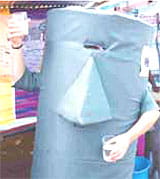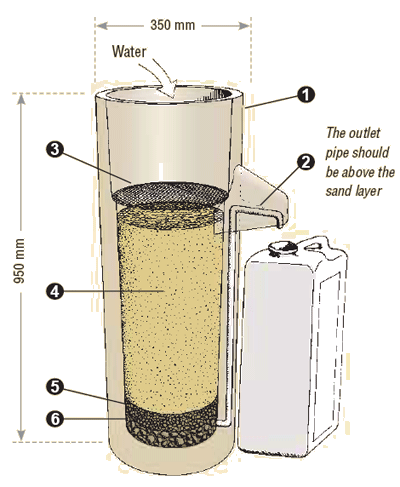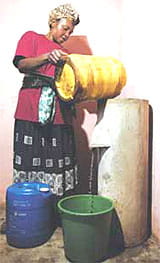Using the filter at home
After three weeks, filtered water will be safe to drink – tests show that around 99% of microbes and contaminants are removed. Water is simply poured in and collected from the spout in clean containers. The filter holds 20 litres of water.
After filling the filter, water will need to be collected in a clean jerrycan. Normally one litre of water is filtered every minute, so it will take 20 minutes for the contents of a 20 litre bucket to pass through the filter. The filter can be used as often as needed.
Maintaining the filter
Users must be given clear information about how to use and maintain the filters. Maintenance is very simple and free. There are just a few important points that people need to remember:
- If water is not poured into the filter every day the schmutzdecke can become less effective.
- Children and animals must not be allowed to touch the spout so that it remains clean.
- The filter must not be knocked or moved.
- The diffuser plate must always be in place when water is poured in to prevent damage to the schmutzdecke.
- Over time, the schmutzdecke may become very thick so that water takes a very long time to pass through the filter. If this happens there are two options:
GENTLE STIRRING Block the spout and fill the filter with water. Stir the water very gently and slowly with a clean hand. Don’t swirl too fast or the sand layers will be disturbed. Scoop the muddy water out with a cup, taking care not to touch the sand. You can repeat this a few times until the water is no longer very dirty during swirling. Unblock the spout and allow the water to pass through the filter as normal. It will be safe to drink almost immediately.
THOROUGH CLEANING Remove carefully the top 2–5cm of sand, wash it and replace it. Unless gentle stirring fails to restore a good flow rate, this method is not really recommended because it disturbs the schmutzdecke. It is therefore really important to wait three weeks before using the water again to ensure it is safe to drink.
Cleaning should be done only if the rate of water flow becomes too slow. Careful monitoring is recommended to ensure people are confident about how to do this. During the three weeks of waiting needed after thorough cleaning, other low-cost methods of making water safe for drinking can be used, such as boiling, SODIS (see Footsteps 51 and www.sodis.org) or using water from a neighbour’s filter.
Compiled with information from Nathalie Vezier, Disaster Management Team, South Kivu (Email: [email protected]) and Adriaan Mol (Email: info@biosandfi lter.org)
Photos: BushProof Illustration: Rod Mill
Case study
The Swiss-based NGO, Medair, trained technicians to make these filters in Machakos, Kenya, in the late 1990s. They educated people about their potential. Medair worked in the area for only a year, during which 400 filters were sold. A recent evaluation showed that over 2,000 filters were sold over four years, providing health benefits while generating income! The business of producing filters proved very successful and the technicians had set up businesses in new areas to meet the demand.
Contact information
www.biosandfilter.org is a very useful website which contains detailed technical information on how to build the metal mould and how to produce the filters.
BushProof is an organisation that provides training in the production of the filters.
Website: www.bushproof.com











